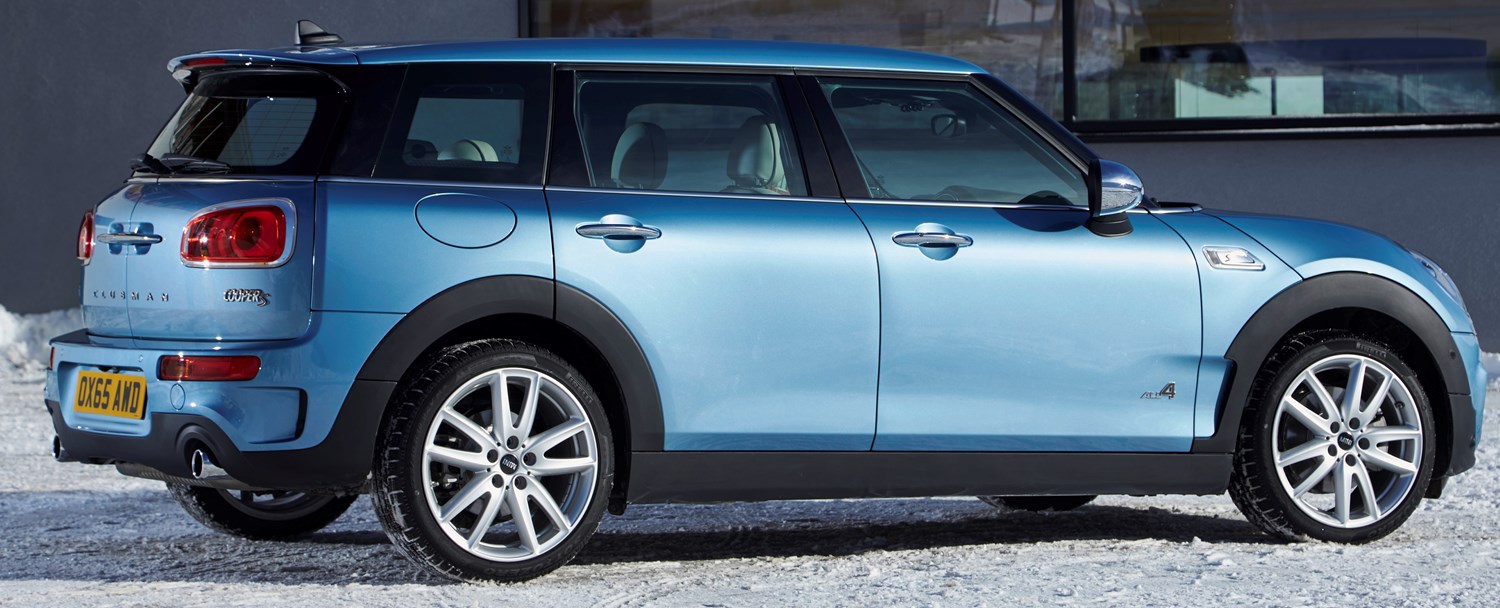Review
The Mini Clubman is a stylish and well-finished small estate car, first introduced in 2007. Offering better levels of practicality than the hatch upon which it is based, the Clubman addressed many issues that people had with the standard car’s levels of space.
As with any ‘new’ Mini it came with a huge level of customisation, with a vast array of colours and specs to choose from.
Accompanied by a strong range of engines, the first-generation Clubman was just as fun to drive as the hatch variant, especially in John Cooper Works layout. That said, even economical diesel versions were just as exciting in the bends.
Latest model
The latest-generation Clubman was introduced in 2015, bringing with it even more space, as well as four doors rather than three and a backwards opening side door as found on the car, is replaced.
This latest model also benefitted from Mini’s all-wheel drive system, giving drivers additional traction in slippery conditions should they want it. On top of this, the new Clubman came with Mini’s latest range of engines, going from a three-cylinder turbocharged petrol to a larger four-cylinder petrol.
At the top sits the 2.0-litre turbocharged unit used in the Cooper S and John Cooper Works variants, producing 228bhp in the latter car. Cleaner and more efficient than before, they bring the Clubman completely up to date.
Value for money
Mini cars have always had a high level of build quality and robustness. However, they haven’t always been the best value for money with limited amounts of standard equipment, depending on which specification you go for.
The range now starts with the Clubman One, priced at £19,090. For that, you get 16-inch alloy wheels and cloth upholstery, as well as ambient lighting.
Parking sensors are also included, which should make placing the car a little easier too. However, that really is about it – there’s not a huge much more as standard.
However, for just £80 more you could have a 2011-year car in Cooper S trim with just 46,259 miles on the clock. Though the previous-generation and therefore not as spacious, this model features 17-inch alloy wheels, air conditioning, partial leather and Bluetooth connectivity.
Keep it well maintained, and this price shouldn’t drop a huge amount – another benefit of buying into the Mini brand.
Looks and image
When the ‘new’ Mini was first released, its looks were at the heart of its appeal. This is still the same for the Clubman, which trades heavily on its retro styling. It also maintained the standard car’s driving appeal, with sports models in particular offering an involving drive to enthusiasts.
All of this was achieved with a high level of fit and finish. Thankfully, this hasn’t changed at all with the latest model, which appears to look more like its owner BMW’s cars more than ever. From its split rear doors that open from the key fob, to the ambient lighting that can be customised with a range of colours, the Clubman is really a lovely place to be.
As mentioned earlier, the last redesign occurred in 2015, so there are quite a few used examples on the market today. There could be an updated car on the horizon, but it’s likely to be a subtle refresh of the current car rather than an all-out overhaul.
Space and practicality
This is the area that the Clubman aims to impress. Bigger than ever before, it looks to give people the levels of practicality that just can’t be achieved in the smaller hatch. As such, you get 360 litres of boot space as standard, which rises to 1,250 litres with the rear seats folded flat. The boot floor also sits completely flush with the boot lip, which makes loading larger items into the rear of the car a lot easier.
Though it looks quite long in appearance, the Mini only just longer than a Volkswagen Golf. However, there’s a decent amount of legroom in the back, while those up front have plenty of space and a good forward view thanks to a wide windscreen.
Engines
There’s a good range of engines offered with the current Mini Clubman, with all of them offering good levels of economy and power. The smallest engine in the range is a four-cylinder petrol, which produces 102bhp and 180Nm of torque. It’s still happy to reach 60mph in 10.9 seconds, and will hit a top speed of 115mph.
You’ll also see an impressive combined economy figure of 55.4mpg, as well as emissions of 119g/km CO2. If you’re after the best fuel efficiency, then the four-cylinder petrol is your best bet, as it’ll return 74.3mpg and emit just 99g/km CO2.
Up next is the four-cylinder 1.5-litre turbocharged engine found in Cooper models. This produces 136bhp and 220Nm torque, while fuel consumption sits at 55.4mpg combined and emissions at 118g/km CO2. It’ll hit 60mph in a respectable 8.9 seconds. Again, there’s a diesel option with the Cooper D Clubman. This reaches 60mph quicker than the petrol in 8.4 seconds, but economy is up at 68.9mpg combined.
Finally, the 2.0-litre turbocharged engine in the Cooper S sits at the top of the range. It puts out 190bhp and 280Nm of torque, allowing it to reach 60mph in just seven seconds. It’s quite a lot of performance for a standard family car, and it certainly makes for an invigorating drive.
This new wave of engines brings a lot more economy, without losing any performance. It’s also worth noting that within the Mini range, more often than not the diesels are level-pegging with the petrol units in their speed to 60mph.
Running costs
Running costs for the Clubman shouldn’t be too bad, with the aforementioned engines helping to fuel costs down. Of course, opt for a more powerful petrol engine and you’ll spend a bit longer at the pump, but most units serve up decent economy.
Costs for consumables like tyres and brakes will be higher on sports models, with these riding on larger wheels – and therefore more rubber. Mini’s do tend to scrub the tread off the front tyres quicker than the rears, too.
If you’re looking to keep road tax costs down, then the diesel variants are the safest bet as these have impressively low CO2 figures. The One D Clubman, for instance, drops below the all-important 100g/km CO2 level, ensuring that tax costs aren’t too high. Insurance premiums will be a little higher than with other rivals, however, owing to the Mini’s high output and desirable nature.
Things to look out for
As they’re built by BMW, Minis have, for the most part, been quite reliable. Some recalls have been administered, however, with many cars affected by the risk of fire in 2012. This was caused by a circuit board overheating close to the turbocharger which, ‘in exceptional cases’ could lead to fire.
It’s still best to ensure that work to address this problem has been completed on any used car that you’re considering the purchase of.
Older models suffer with troublesome power steering pumps, which can give way completely in high-mileage cars. Clutches are another sticking point, as are the exhaust brackets, with the latter susceptible to rust.
Rivals
When the Clubman dropped the use of its quirky reverse-opening door, it entered into a competitive segment. Though they’re more traditional in appearance, the Mini’s main rivals come in the form of the Volkswagen Golf and Audi A3 Sportback, as well as the Mercedes A-Class. All accomplished cars in their own rights, they certainly mean that the Mini has a tricky job on its hands, especially considering its nearness in price to many of the vehicles here.
Depreciation warning
This something that Mini owners, traditionally, don’t have to worry about. All cars in the line-up have excellent residuals, though in truth the Clubman does the worst of the group. Even so, it’ll lose a lot less of its value when compared to more budget rivals. Higher-spec sports models – as well as the diesels – will do better at holding their values, too.





